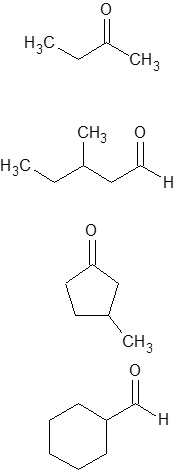
General, Organic, and Biological Chemistry: Structures of Life (5th Edition)
5th Edition
ISBN: 9780321967466
Author: Karen C. Timberlake
Publisher: PEARSON
expand_more
expand_more
format_list_bulleted
Question
Chapter 14.1, Problem 14.1QAP
Interpretation Introduction
Interpretation: Classify the following carbonyl compounds as a

Concept introduction:
a) Carbonyl compounds are classified into two categories: Ketone and Aldehyde
b) The aldehyde differs from ketone in having one hydrogen attached to carbonyl carbon.
Expert Solution & Answer
Want to see the full answer?
Check out a sample textbook solution
Students have asked these similar questions
First image: I have to explain why the molecule C is never formed in those conditions.
Second image: I have to propose a synthesis for the lactone A
First image: I have to explain why the molecule C is never formed in these conditions
Second image: I have to propose a synthesis for the lactone A
Help fix my arrows please
Chapter 14 Solutions
General, Organic, and Biological Chemistry: Structures of Life (5th Edition)
Ch. 14.1 - Prob. 14.1QAPCh. 14.1 - Prob. 14.2QAPCh. 14.1 - Prob. 14.3QAPCh. 14.1 - Prob. 14.4QAPCh. 14.1 - Prob. 14.5QAPCh. 14.1 - Prob. 14.6QAPCh. 14.1 - Prob. 14.7QAPCh. 14.1 - Prob. 14.8QAPCh. 14.1 - Prob. 14.9QAPCh. 14.1 - Prob. 14.10QAP
Ch. 14.1 - Prob. 14.11QAPCh. 14.1 - Prob. 14.12QAPCh. 14.2 - Prob. 14.13QAPCh. 14.2 - Prob. 14.14QAPCh. 14.2 - Prob. 14.15QAPCh. 14.2 - Prob. 14.16QAPCh. 14.2 - Prob. 14.17QAPCh. 14.2 - Prob. 14.18QAPCh. 14.3 - Prob. 14.19QAPCh. 14.3 - Prob. 14.20QAPCh. 14.3 - Prob. 14.21QAPCh. 14.3 - Prob. 14.22QAPCh. 14.3 - Prob. 14.23QAPCh. 14.3 - Prob. 14.24QAPCh. 14.4 - Prob. 14.25QAPCh. 14.4 - Prob. 14.26QAPCh. 14.4 - Prob. 14.27QAPCh. 14.4 - Prob. 14.28QAPCh. 14.4 - Prob. 14.29QAPCh. 14.4 - Prob. 14.30QAPCh. 14.5 - Prob. 14.31QAPCh. 14.5 - Prob. 14.32QAPCh. 14.5 - Prob. 14.33QAPCh. 14.5 - Prob. 14.34QAPCh. 14.5 - Prob. 14.35QAPCh. 14.5 - Prob. 14.36QAPCh. 14.5 - Prob. 14.37QAPCh. 14.5 - Prob. 14.38QAPCh. 14.5 - Prob. 14.39QAPCh. 14.5 - Prob. 14.40QAPCh. 14.5 - Prob. 14.41QAPCh. 14.5 - Prob. 14.42QAPCh. 14 - Prob. 14.43UTCCh. 14 - The compound frambinone has the taste of...Ch. 14 - Prob. 14.45UTCCh. 14 - Prob. 14.46UTCCh. 14 - Prob. 14.47UTCCh. 14 - Prob. 14.48UTCCh. 14 - Prob. 14.49UTCCh. 14 - Prob. 14.50UTCCh. 14 - Prob. 14.51AQAPCh. 14 - Prob. 14.52AQAPCh. 14 - Prob. 14.53AQAPCh. 14 - Prob. 14.54AQAPCh. 14 - Prob. 14.55AQAPCh. 14 - Prob. 14.56AQAPCh. 14 - Prob. 14.57AQAPCh. 14 - Prob. 14.58AQAPCh. 14 - Prob. 14.59AQAPCh. 14 - Prob. 14.60AQAPCh. 14 - Prob. 14.61AQAPCh. 14 - Prob. 14.62AQAPCh. 14 - Prob. 14.63AQAPCh. 14 - Prob. 14.64AQAPCh. 14 - Prob. 14.65AQAPCh. 14 - Prob. 14.66AQAPCh. 14 - Prob. 14.67AQAPCh. 14 - Prob. 14.68AQAPCh. 14 - Prob. 14.69AQAPCh. 14 - Prob. 14.70AQAPCh. 14 - Prob. 14.71CQCh. 14 - Prob. 14.72CQCh. 14 - Prob. 14.73CQCh. 14 - Prob. 14.74CQCh. 14 - Prob. 14.75CQCh. 14 - Prob. 14.76CQCh. 14 - Prob. 14.77CQCh. 14 - Prob. 14.78CQCh. 14 - A compound called butylated hydroxytoluene, or...Ch. 14 - Prob. 28CICh. 14 - Prob. 29CICh. 14 - Prob. 30CICh. 14 - Prob. 31CICh. 14 - Cl.32 lonone is a compound that gives sweet...Ch. 14 - Prob. 33CICh. 14 - Prob. 34CI
Knowledge Booster
Similar questions
- Provide the drawing of the unknown structure that corresponds with this data.arrow_forward20.44 The Diels-Alder reaction is not limited to making six-membered rings with only car- bon atoms. Predict the products of the following reactions that produce rings with atoms other than carbon in them. OCCH OCCH H (b) CH C(CH₂)s COOCH མ་ནས་བ (c) N=C H -0.X- (e) H C=N COOCHS + CH2=CHCH₂ →→arrow_forwardGiven the attached data, provide the drawing for the corresponding structure.arrow_forward
arrow_back_ios
SEE MORE QUESTIONS
arrow_forward_ios
Recommended textbooks for you
 ChemistryChemistryISBN:9781305957404Author:Steven S. Zumdahl, Susan A. Zumdahl, Donald J. DeCostePublisher:Cengage Learning
ChemistryChemistryISBN:9781305957404Author:Steven S. Zumdahl, Susan A. Zumdahl, Donald J. DeCostePublisher:Cengage Learning ChemistryChemistryISBN:9781259911156Author:Raymond Chang Dr., Jason Overby ProfessorPublisher:McGraw-Hill Education
ChemistryChemistryISBN:9781259911156Author:Raymond Chang Dr., Jason Overby ProfessorPublisher:McGraw-Hill Education Principles of Instrumental AnalysisChemistryISBN:9781305577213Author:Douglas A. Skoog, F. James Holler, Stanley R. CrouchPublisher:Cengage Learning
Principles of Instrumental AnalysisChemistryISBN:9781305577213Author:Douglas A. Skoog, F. James Holler, Stanley R. CrouchPublisher:Cengage Learning Organic ChemistryChemistryISBN:9780078021558Author:Janice Gorzynski Smith Dr.Publisher:McGraw-Hill Education
Organic ChemistryChemistryISBN:9780078021558Author:Janice Gorzynski Smith Dr.Publisher:McGraw-Hill Education Chemistry: Principles and ReactionsChemistryISBN:9781305079373Author:William L. Masterton, Cecile N. HurleyPublisher:Cengage Learning
Chemistry: Principles and ReactionsChemistryISBN:9781305079373Author:William L. Masterton, Cecile N. HurleyPublisher:Cengage Learning Elementary Principles of Chemical Processes, Bind...ChemistryISBN:9781118431221Author:Richard M. Felder, Ronald W. Rousseau, Lisa G. BullardPublisher:WILEY
Elementary Principles of Chemical Processes, Bind...ChemistryISBN:9781118431221Author:Richard M. Felder, Ronald W. Rousseau, Lisa G. BullardPublisher:WILEY

Chemistry
Chemistry
ISBN:9781305957404
Author:Steven S. Zumdahl, Susan A. Zumdahl, Donald J. DeCoste
Publisher:Cengage Learning

Chemistry
Chemistry
ISBN:9781259911156
Author:Raymond Chang Dr., Jason Overby Professor
Publisher:McGraw-Hill Education

Principles of Instrumental Analysis
Chemistry
ISBN:9781305577213
Author:Douglas A. Skoog, F. James Holler, Stanley R. Crouch
Publisher:Cengage Learning

Organic Chemistry
Chemistry
ISBN:9780078021558
Author:Janice Gorzynski Smith Dr.
Publisher:McGraw-Hill Education

Chemistry: Principles and Reactions
Chemistry
ISBN:9781305079373
Author:William L. Masterton, Cecile N. Hurley
Publisher:Cengage Learning

Elementary Principles of Chemical Processes, Bind...
Chemistry
ISBN:9781118431221
Author:Richard M. Felder, Ronald W. Rousseau, Lisa G. Bullard
Publisher:WILEY